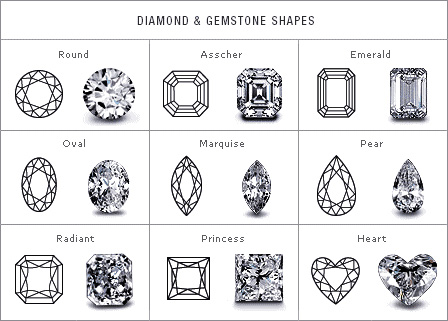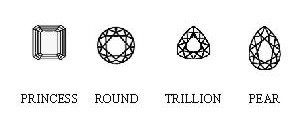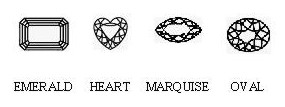GEMSTONE
SHAPES
In
nature, the shape of a gemstone is determined by its natural crystal
structure and the conditions under which the crystal developed.
To enhance the natural beauty of the crystal and to provide a safe
shape for mounting, gem cutters form natural gemstones into precise
shapes. These shapes typically include a number of flat, symmetrical
planes, called facets, which reflect light to add sparkle and brilliance
to the finished stone.
Gemstone cutting is based in science. Each gem material has a known
refractive index which allows a gem cutter to determine how light
rays will bend as they pass through the stone. Using this information
a gemstone can then be precisely shaped to best enhance its natural
beauty.
If a well shaped multi-faceted stone is viewed from above it will
appear very bright across the entire surface. This brightness results
from light rays being reflected directly from the top surface, as
well being reflected within the gemstone and back to your eye. You
cannot see through a well cut gemstone, even though the natural
material is translucent, since almost all of the light is being
reflected back to the viewer. [Obviously this is not the case with
stones which are intentionally shaped with larger facets, such as
a traditional emerald cut.]
If a gemstone is not as well shaped it will be possible to look
down on the top surface and see through to the point at the bottom
of the stone. This transparent effect is called a "window."
Windows detract from the brilliance and color of a stone, since
light be allowed to pass directly through the materials without
reflecting back to the viewers eye.
Not all gemstones are faceted. For example, opals are suited to
a smooth, rounded surface, and are often found with pleasing shapes
which naturally highlight their internal flashes and sparkles. Other
gems are formed into smooth, rounded shapes called cabochons. Some
"cabo's" are also referred to as "star" gems
due to the distinctive light pattern which appears as a result of
inclusions in the stone.
\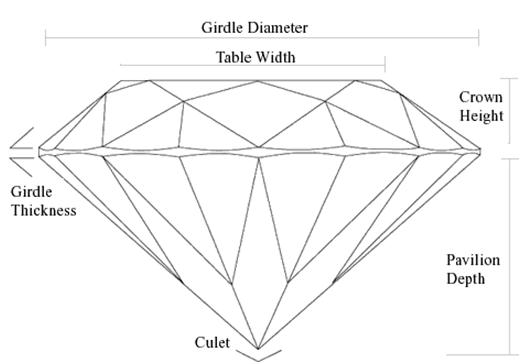
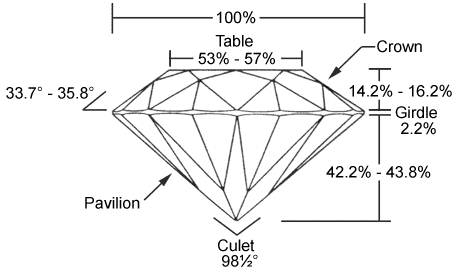
Understanding
cuts in Gemstones :
When grading and appraising gemstones, cut may not be as influential
as the other C's like color, clarity, and carat weight, but it
is definitely an influencing factor when it comes to the gemstones
overall beauty. To properly evaluate the cut of a given gemstone,
you must not only study the face-up view or the surface or top
view but study it from all other angles as well. An excellent
cut can reduce loss on carat weight but enhance its looks to breathtaking
proportions at the same time.
Common Cuts Used on Gemstones :
1.
Brilliant Cuts :
A brilliant-cut gemstone usually has three flat polished surfaces
per facet. They are positioned in such a way to radiate the best
light from the gemstone. Gemstone cutters also make sure that the
angles will enhance the brilliance of the gemstone. Brilliant cuts
are mostly used for diamonds and transparent gemstones.
Some
facets will have one or more shapes like stars, hearts, kites, and
lozenges. Variations of the brilliant cut include the naivet or
boat-shaped marquise, pear-shaped pendeloque, and oval shape. Oval
shapes are suitable for gemstones with lower carat weight because
they can make them appear bigger.
The
most popular variation of all is the full-cut round brilliant. It
has fifty-eight facets, presently the greatest count for brilliant
cut gemstones. The single brilliant cut, on the other hand, has
seventeen to eighteen facets. For gemstones used in earrings and
pendants, the briolette variation is mostly used to provide it with
circular cross-section teardrop shapes. Brilliant cuts with triangular
dimensions are called trilliants while square brilliant cuts are
also known as princess cuts.
2.
Step Cuts :
Another popular cut for a gemstone is the step or trap cut. Step
cuts are best used for colored gemstones because they possess four-sided
table facets and girdles as well as parallel quadrilateral facets.
The term step cut was used because this gemstone cut bears similarities
with a staircase. Step cuts have fewer facets than brilliant cuts.
One
well-known variation of a step cut is the baguette. It is rectangular
in shape but with square corners. Emerald cuts are also quite popular.
Its name was derived from its consistent use with emeralds. Emerald
cuts remove the corners and form an octagonal shape. Clipping off
the corners protect delicate gemstones like emeralds and facilitate
setting of gemstones at the same time. Other popular variations
for step cuts are window, table, radiant, and oval.
The best advantage of step cuts is its ability to enhance a gemstones
color, making the color richer and appearing to have originated
straight from the belly of the gemstone.
3.
Mixed Cuts :
Mixed cuts for gemstones are mostly combinations of brilliant and
step cuts. The crown or top portion of a gemstone will resemble
a brilliant cut while the pavilion or bottom portion of a gemstone
will receive a step cut. At times, the two cuts will appear side
by side. Mixed cuts are also characterized by their rounded outlines.
Many transparent gemstones like rubies and sapphires are often cut
this way. Gemstones with mixed cuts are also commonly set in prongs.
Variations
for mixed cuts include but are not limited to cushion, zircut, pear
or teardrop, and oval.
4.
Cabochon Cuts :
A gemstone with a cabochon cut will appear rounded on top and flat
on the bottom. At times, gemstones will only appear in this cut.
Height of a gemstones dome with a cabochon cut varies. The name
is derived from the French term used for bald heads. Cabochon cuts
are simplest to make, and that is why you will often see them used
on affordable gemstones and those that will not benefit from faceting.
5.
Fancy Cuts :
Any other cut besides those mentioned above is usually referred
to as fancy. A checkerboard cut, for instance, will have a combination
of a large table facet on top and a mixed cut. A rose cut will have
a round girdle outline, flat base, dome-shaped crown, and facets
of a brilliant cut.
When
judging the cut of a gemstone, start by evaluating it face up. See
if the gemstone shows uniform color distribution and radiates light
in the best possible way. Gemstones cut with large windows are unappealing.
Lastly, recheck all other angles and determine if the cut took both
carat weight and looks into consideration.

